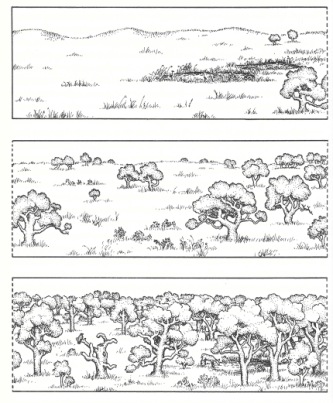Prairie

Original prairie survives along Deer Grove. The herbs include original populations of such rare species as dropseed grass, violet wood sorrel, hoary puccoon, and shooting star. In the original survey map of the Northbrook area, surveyed in 1839, the open prairie stretched unbroken from bottom of the slope west to the Des Plaines River. The best quality prairie is in Deer Grove, around the paved paths. As good quality acreage increases with restoration, prairie birds can be expected to return to nest – including bobolink, meadowlark, sedge wren, and grasshopper sparrow.
Savanna
Most of the sunny open areas in Deer Grove are tallgrass savanna, a natural community where grasses and wildflowers grow amid scattered trees, mostly bur and scarlet oaks. The herbs here include all the species of typical prairie and others more typical of woods. Mixed with them are species more typical of the savanna; examples include cream gentian, Seneca snakeroot, pale Indian plantain, purple milkweed, and many others. Typical birds include indigo bunting, orchard oriole, cedar waxwing, and eastern kingbird. Typical savanna butterflies include the great spangled fritillary, wood nymph, coral hairstreak, and the red-spotted purple. Natural shrubland, as part of the savanna, contains such shrubs as hazelnut, wild plum, sumac, dogwood, and viburnum.
Woodland
Areas where more than half of the ground is shaded by trees are called woodland. Here the main tree species are oaks (bur, white, swamp white, red, and scarlet), hickory (shagbark and bitternut) and black walnut. The main woodland areas are in the eastern two-thirds of Deer Grove. In addition to the savanna shrubs, understory trees and shrubs include black haw, silky dogwood, hawthorn, and hop hornbeam. Typical herbs include elm-leaved goldenrod, Joe-pye-weed, wild geranium, and wood reed. Butterflies include the Appalachian brown, question mark, and many species of hairstreaks. Typical birds include great crested flycatcher, eastern wood pewee, and Baltimore oriole.
Ephemeral Pools
Two or three feet deep in spring, but entirely dry most of the summer and fall, these ponds are important breeding places for the western chorus frogs, spring peepers, blue-spotted salamanders, and other amphibians which live in the savannas and woodlands during other times of the year.